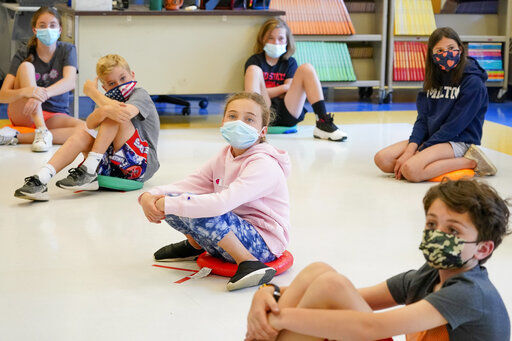NEW YORK — As more children go back to the physical classroom, families are expected to spend robustly on a wide range of items, particularly trendy clothing like cropped tops, for the critical back-to-school season, according to one key spending measure.
Mastercard SpendingPulse, which tracks spending across all payment forms including cash, forecasts that spending will be up 5.5% between July 15 and Sept. 6. That’s compared with the year-ago period when sales were up a meager 1.2% as the pandemic wreaked havoc on schools’ reopening plans and back-to-school shopping.
Last year, parents focused their spending online and bought supplies and electronics to help their children set up work stations at home. When it came to apparel, they limited their purchases to sweatpants and other comfy clothes for their kids and avoided department stores.
In a more telling sign of a rebound, back-to-school sales should increase 6.7% on a two-year basis, according to Mastercard SpendingPulse. The figures exclude sales from autos and gas.
The rosy forecast, issued today, comes as retailers, particularly mall-based stores, are seeing a strong recovery as newly vaccinated shoppers feel safe going out and socializing. On Wednesday, the National Retail Federation, the nation’s largest retail trade group, sharply revised its annual outlook for retail sales. It now expects the increase to be anywhere from 10.5% to 13.5% compared to an earlier forecast made in February of at least 6.5%.
“The economy and consumer spending have proven to be much more resilient than initially forecasted,” said Matthew Shay, president and CEO of the retail trade group, in a statement. “The combination of vaccine distribution, fiscal stimulus and private-sector ingenuity have put millions of Americans back to work.”
While NRF noted risks related to worker shortages, an overheating economy, tax increases and over-regulation, it pointed out that overall households are healthier, and consumers are showing their ability and willingness to spend.
The downside is that many retailers might not be able to fully capitalize on this sudden surge of spending. For many items produced overseas, stores had to place their orders at least six months ago, and they were conservative, says Steve Sadove, senior adviser for Mastercard and former CEO and chairman of Saks Inc. He also cited the logjam at ports, making it difficult for retailers to bring in goods to their stores.
“The supply chain is backed up. The ports are backed up,” he said. “You’re going to find scarcity.” He said that a number of retailers he has spoken to are having to air ship items instead of transport them by boat in order to have them get to the stores in time for back-to-school.
For this back-to-school season, Sadove said clothing should enjoy a stronger-than-expected rebound, with Mastercard SpendingPulse forecasting a 78.2% sales increase compared with last year. On a two-year basis, the figure is expected to be up 11.3%. Sadove said that retailers are seeing a shift in consumer spending toward trendier items like cropped tops and mini skirts.
In particular, department stores are enjoying a solid recovery after struggling last year with stiff competition from discount stores like Walmart and Target. The department sector’s sales should be up 25.3% during the back-to-school period, compared to a year ago. Sales should rise 9.5% on a two-year basis.
Sadove told The AP that department stores are reaping the benefits of their moves to expand into online services like allowing online shoppers to pick up orders at the stores. They’re also expanding into new categories like wellness.
Consumer electronics should have strong sales growth compared to a year ago and on a two-year basis. But online sales are expected to drop 6.6% for this period compared to last year when shoppers focused mostly on buying online. Still, that figure should be up 53.2% on a two-year basis, according to Mastercard SpendingPulse.


